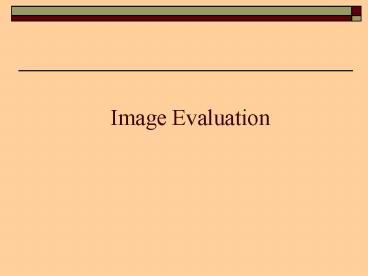Image Evaluation - PowerPoint PPT Presentation
1 / 38
Title:
Image Evaluation
Description:
May also be called Image Interpretation Different to Image Critique which ... Nasal Polyp. Ghorayeb, B. 2006. This ones infected! Ghorayeb, B. 2006 ... – PowerPoint PPT presentation
Number of Views:150
Avg rating:3.0/5.0
Title: Image Evaluation
1
Image Evaluation
2
What is Image Evaluation?
- May also be called Image Interpretation
Different to Image Critique which discusses
evaluation of images from a technical point of
view. Patient position, exposure, inclusion of
correct anatomy etc. - Image Evaluation discusses radiographic pathology
or abnormal radiographic appearances. - It will begin to equip you with the terminology
required to describe abnormal radiographic
appearances. - Note! Before you can identify what is abnormal,
you must first learn to recognise what is normal!
3
- It takes time to learn what is normalDONT
PANIC!
4
Image Evaluation has two parts.
- Describing what you seeusing appropriate and
professional terminology - Providing a diagnosis.
5
Example
6
(No Transcript)
7
Thats a grotty
looking chest!
8
Triangular shaped density in the mid
zone of the right hemi-thorax probably
representing airspace opacification.Horizontal
line represents an air/fluid interface at the
junction of the upper and middle
lobes.Diagnosis Rt upper lobe pneumonia
9
Interesting Images
10
Interesting Images
- Trauma e.g MVA (Motor Vehicle Accident)
- Transverse fracture of the mid-shaft of the left
humerus. - 45degree varus angulation of the distal fragment.
- External rotation of the distal fragment around
the fracture site.
11
- As is typical of the field of imaging Image
Evaluation provides a pathway of learning that is
almost never ending. Remember lifelong learning! - Image Evaluation will teach you mainly about the
most commonly encountered pathologies.
12
Musculoskeletal Colloquialisms
(Colloquial informal speech
or conversation)
- Some radiographic pathologies can be described in
very plain and un-scientific language, but convey
a complete and accurate picture
13
Chauffeur Fracture
Lee, 2004
14
Chauffeur Fracture
- In the days when cars had to be hand-cranked to
start. - The crank would kick back or backfire against
the hand putting pressure on the wrist joint.
Lee, 2004
15
Boxers Fracture
Lee, 2004
16
Boxers Fracture.
- Also called a Saturday night fracture, or
bar-room fracture. - Be sure to aim well when you throw a punch!
Lee, 2004
17
Clay-shovelers Fracture
Lee, 2004
18
Clay-shovelers Fracture
- Fracture of the spinous process usually C6 or
C7. - Was noted as an injury in men employed to dig
drainage ditches in clay soil in western
Australia. - The clay was tossed out on long handled shovels.
- Sometimes the clay stuck to the shovel causing
strain on the neck and back muscles causing a
tearing of the spinous process.
Lee, 2004
19
Greenstick Fracture
Lee, 2004
20
Greenstick Fracture
- Typically occurs in young children where the
bones are growing. - Fracture on one side of the bone, and bone cortex
(edge) remains intact on the other. - Compare this to snapping a young green sapling
twig, it does not snap completely hence the
name.
Lee, 2004
21
Nightstick Fracture.
Lee, 2004
22
Nightstick Fracture
- Caused typically when arm is raised in defence,
to protect against a blow from a policemans
baton, or nightstick. - Fracture typically occurs in the middle third of
the ulna the bone to be contacted.
Lee, 2004
23
Wagon Wheel Fracture.!
Lee, 2004
24
Wagon Wheel Fracture.!
- In the days of horse and cart, or wagon.
- Children used to hitch a ride.
- Leg caught in spokes of wagon wheel which then
causes twisting and forced extension of the leg. - Fracture through the epiphysis or growth plate of
the distal femur
Lee, 2004
25
A normal horizontal ray lateral knee radiograph
Normal epiphysis
Lee, 2004
26
Metaphysis Flared end of long bone
Diaphysis shaft of long bone
Epiphysis secondary ossification centre
Physis or growth plate where lengthways growth
of bone is layed down
27
How about?
- A Casanova's fracture?
- A Lovers Fracture?
- A Hangmans Fracture?
- A March Fracture?
- Gamekeepers thumb?
28
Nasal Polyp
Ghorayeb, B. 2006
29
This ones infected!
Ghorayeb, B. 2006
30
Plain film imaging can also be used to evaluate
soft tissues particularly of the abdomen
31
Gas in the stomach, called a gastric bubble
Gas in the intestine
Faeces contents of the bowel
32
(No Transcript)
33
Chicken bone
Trachea
34
(No Transcript)
35
Clavicle
36
Osteolytic metastasis (secondary tumor deposits)
of proximal left humerus with complete bony
destruction
Osteolytic destruction bone destroying Osteoblas
tic bone forming
Eisenberg Johnson, 2003
37
Test
- Pyrexia?
- Tachycardia?
- Epistaxis?
- Thenar Eminence?
38
References
- Eisenberg, R.L. Johnson, N.M. Comprehensive
Radiographic Pathology. Mosby. 2003. - Ghorayeb, B. 2006. Anatomy of the sinuses,
Otolaryngology Houston. Viewed 11 June 2006.
http//www.ghorayeb.com/AnatomySinuses.html - Lee P, Hunter T, and Taljanovic M, 2004.
Musculoskeletal Colloquialisms How Did We Come
Up with These Names? Radiographics. Viewed 15
July 2006. lthttp//radiographics.rsnajnls.orggt































